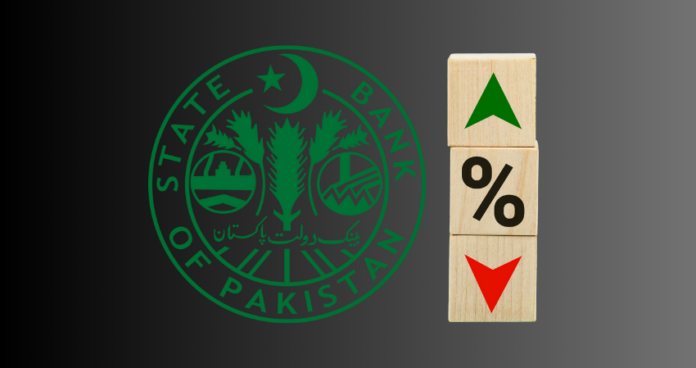The Monetary Policy Committee (MPC) of the State Bank of Pakistan (SBP) met today to decide about the Monetary Policy and opted to maintain the policy rate at 22% during its meeting on Monday, March 18, 2024.
The decision was in line with analysts’ expectations.
The central bank last hiked the policy rate by 100 basis points (bps) to 22% in an emergency meeting in June ahead of an agreement with the International Monetary Fund (IMF). Since then, it has maintained the rate at 22%.
The MPC acknowledged that as anticipated, inflation has started to decrease significantly in the latter part of the fiscal year 2024. Headline inflation registered a broad-based and considerable year-on-year decline from 28.3% in January to 23.1% in February.
Core inflation, which is another measure that excludes volatile components such as food and energy prices from inflation calculations, and had previously shown resistance to change, also slowed to 18.1% in February from 20.5% in January.
The MPC attributed the improvement in inflation to the combined impact of contractionary monetary policy, fiscal consolidation, better food supplies, moderating global commodity prices and favourable base effect.
However, the MPC observed that while energy inflation also decelerated on a year-on-year basis in February, the adjustments in administered energy prices have continued to contribute to inflation directly and indirectly. Going forward, any further adjustments in administered prices or fiscal measures that may push prices up pose a risk to the near- and medium-term inflation outlook. Cognisant of these risks, the Committee assessed that it is prudent to continue with the current monetary policy stance at this stage.
“This warrants a cautious approach and requires continuity of the current monetary stance to bring inflation down to the target range of 5-7% by September 2025. The Committee reiterated that this assessment is also contingent upon continued targeted fiscal consolidation and timely realisation of planned external inflows”, read the monetary policy press release.
The MPC also observed that globally, while the overall trajectory of commodity prices remained stable, there was an uptick in oil prices, driven in part by ongoing tensions in the Red Sea region. This development carries the potential to escalate inflationary pressures.
Finally, MPC also took into consideration the cautious approach taken by major central banks in both advanced and emerging economies that have opted to maintain a prudent monetary policy stance in their recent meetings due to uncertainty of inflation outlook.
Earlier today, Bloomberg predicted that the SBP would likely maintain the current policy stance. The reason it cited was: that the policy rate is below the inflation rate resulting in negative real rates, which is already supporting growth. The report by Bloomberg also highlighted that a potential rate cut could prompt capital outflows, exacerbating the depletion of foreign exchange reserves, which presently cover less than two months of imports. Additionally, the repayment of a $1 billion bond due on April 15 would further strain these reserves.
In the post-analyst briefing, the governor reiterated that SBP’s foreign exchange reserves stand at around $8 billion currently, and the SBP is targeting minimum foreign exchange reserves of $ 9.1 billion by the end of June 2024.
IMF equation
Concurrently, Pakistan is undergoing the last review of the IMF’s $3 billion SBA. The review began on Thursday, March 14, and is expected to last four days. Pakistan will receive the last tranche of $1.1 billion if the last review is successful. This review will also set the tone for the negotiations of a longer economic bailout package to sustain the economy
It is worth noting that the tight monetary stance of the SBP aimed at curbing the price riding levels has been influenced, at least in part, by the conditions set by the Fund.
In the briefing with analysts, the Governor highlighted that discussions are ongoing with the IMF for the final review under the Stand-By Arrangement (SBA), and it is expected to conclude soon. He stated that the central bank has taken all required actions and measures.
Problems with maintaining high-interest rates
The elevated policy rate has had a notable impact on the country’s business environment. Companies have faced challenges in meeting their working capital requirements at these heightened financing rates. Additionally, there has been a decline in demand for goods and services as a result of decreased consumer spending.
Speaking to Profit, independent economic analyst AAH Soomro highlighted the cost of maintaining a high policy rate on Pakistan’s economy. He said that high finance costs for businesses would translate into delayed growth in the profitability of companies thereby delaying capital formation, job creation and tax collection.
“The prevailing risk-off sentiment will continue to persist. Capital holders to refrain from investing in the real economy and continue to enjoy risk-free (albeit sovereign) exposure in the government bonds (treasury bills) and banks (in the form of deposits)”, lamented Soomro.
“High policy rate will lead to additional fiscal cost of debt servicing which would be funded by further taxation measures resulting in higher inflation”, added Soomro. These factors support the argument for maintaining interest rates for a longer period.
However, there is a growing consensus amongst analysts that the trend of monetary easing is likely to commence in April. Bloomberg too anticipates monetary easing in April when inflation potentially slows down to 20%, resulting in positive real rates. Furthermore, if the ongoing discussions with the IMF are favourable, Pakistan would have a larger forex reserve buffer.




